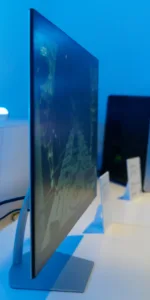Dell was next door to Lenovo in one of the Venetian restaurants and we had a look around, although it was very noisy and crowded!
The most interesting story on the display said was the S2719DM IPS LCD monitor. The brightness is around 600 cd/m² and the monitor will be submitted for testing to receive the HDR600 label. It has 2560 x 1440 QuadHD resolution and will support more than 85% of the DCI P3 colour gamut. However, the real story is the structure.
The monitor is just 5.5mm thick on the edges as it has been built using a glass LGP in the backlight. Dell doesn’t talk about component suppliers, but given that we spotted a sample of the monitor on the Corning booth, we think it’s a good bet that the glass came from Corning! We think this is the first production monitor with a glass LGP. It is expected to sell for $499 in the US. There is also a 23.8″ FullHD version with 400 cd/m² of output and priced at $299. Both monitors will be available at the end of January.
Dell’s new 27″ HDR monitor uses a glass LGP and is just 5.5mm thick at the edge. Image:Meko
Dell is promoting its CinemaColor concept which is intended to deliver high contrast and HDR along with wide colour gamut across a range of different products including notebooks, monitors, and projectors and the concept will also be applied to audio and streaming quality.
We reported on the new version of the flagship XPS 13 notebook recently (Dell XPS13 Boosts Performance) and it was one of the items of news at the show. There is also a new XPS 15 2-in-1, a new model that uses the new module and a revised form factor with an 8th gen Intel Core processor and the Radeon RX Vega M graphics, in a single package (AMD and Intel—Together at Last). The XPS 15 has a 15.6″ InfinityEdge display with UltraHD resolution and covered with Gorilla Glass 4. The PC is 16mm thick. A new feature is a pen that is more sensitive than previous models, and it also responds to tilt in the pen.
The company also announced updates to the Latitude range of PCs to bring them up to the 8th Gen of Intel core processors.
One of the barriers to VR use with PCs has been the level of PC needed and Dell has developed a new range of PCs under the Inspiron sub-brand that can support VR but are available from $799.
Dell also announced new software to integrate mobile calling with PCs, allowing mirroring of the phone on a PC.
Analyst Comment
Unfortunately, by the time we got to the Corning booth in the LVH, staff involved with the Iris LGP had left, but we caught up in an online briefing with Andrew Beck who heads up the initiative in the glass LGPs for Corning. Beck is very pleased to see the Dell product launched and said that he had seen a good response to the idea from monitor brands and makers from the start. (One of the advantages, of course, is that almost all monitors are edge lit, while many TVs are direct lit). The company brought mock-ups to show privately at CES last year (and publicly at SID).
As well as reducing the thickness of monitors, the use of glass makes the LGP less susceptible to heat distortion and this, in turn, makes it slightly easier to design the very narrow bezels which are increasingly being sought. Corning also found in consumer research that buyers were ready to pay more for sleek designs in monitors. Careful matching of the edge LEDs and the LGP can mean better coupling of light into the monitor and this is important. As monitors head to higher brightness, with HDR up to 1,000 cd/m², the relatively small aperture ratio of monitor panels, compared to TVs, can be a challenge. Again, the better stability of glass under heat is an advantage.
We asked about curved LGPs and there are advantages if the glass can be hot bent, but the relatively small size of the curved monitor market makes this segment less attractive at the moment. Tolerances also have to be very tight, which could be a challenge for hot forming.
Beck told us that at CES, Innolux’s set division was privately showing a 65″ TV that was less than 4mm thick.
We went over the broad principles of the concept of QDOG (Will QDOG Have its Day?) and while Beck couldn’t confirm any of the suggested cost data, he did not dispute the core concept that exploiting LGP’s ability to hermetically seal QDs could be a real advantage. (BR)

